Lavanya Elluri
PrivComp-KG : Leveraging Knowledge Graph and Large Language Models for Privacy Policy Compliance Verification
Apr 30, 2024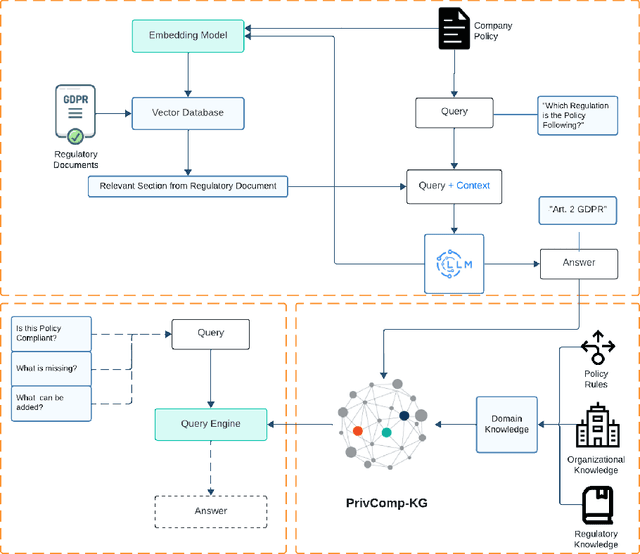
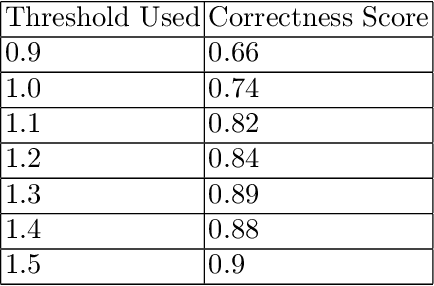
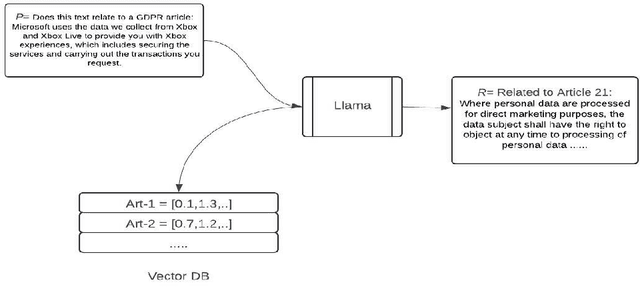
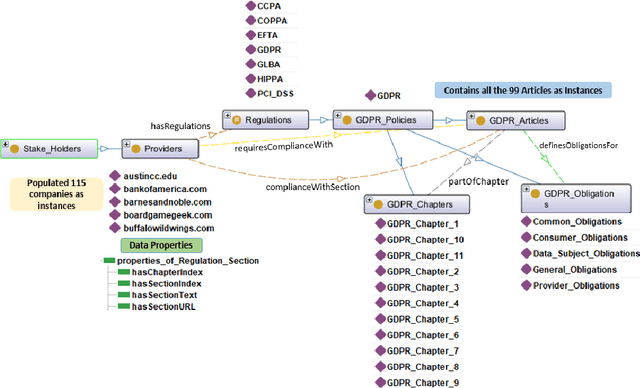
Abstract:Data protection and privacy is becoming increasingly crucial in the digital era. Numerous companies depend on third-party vendors and service providers to carry out critical functions within their operations, encompassing tasks such as data handling and storage. However, this reliance introduces potential vulnerabilities, as these vendors' security measures and practices may not always align with the standards expected by regulatory bodies. Businesses are required, often under the penalty of law, to ensure compliance with the evolving regulatory rules. Interpreting and implementing these regulations pose challenges due to their complexity. Regulatory documents are extensive, demanding significant effort for interpretation, while vendor-drafted privacy policies often lack the detail required for full legal compliance, leading to ambiguity. To ensure a concise interpretation of the regulatory requirements and compliance of organizational privacy policy with said regulations, we propose a Large Language Model (LLM) and Semantic Web based approach for privacy compliance. In this paper, we develop the novel Privacy Policy Compliance Verification Knowledge Graph, PrivComp-KG. It is designed to efficiently store and retrieve comprehensive information concerning privacy policies, regulatory frameworks, and domain-specific knowledge pertaining to the legal landscape of privacy. Using Retrieval Augmented Generation, we identify the relevant sections in a privacy policy with corresponding regulatory rules. This information about individual privacy policies is populated into the PrivComp-KG. Combining this with the domain context and rules, the PrivComp-KG can be queried to check for compliance with privacy policies by each vendor against relevant policy regulations. We demonstrate the relevance of the PrivComp-KG, by verifying compliance of privacy policy documents for various organizations.
Privacy-Preserving Data Sharing in Agriculture: Enforcing Policy Rules for Secure and Confidential Data Synthesis
Nov 27, 2023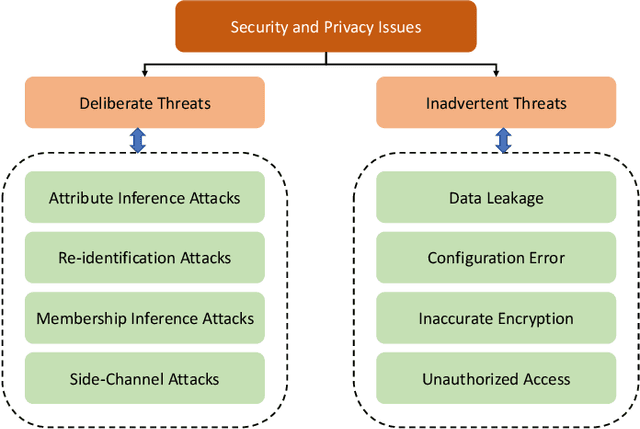
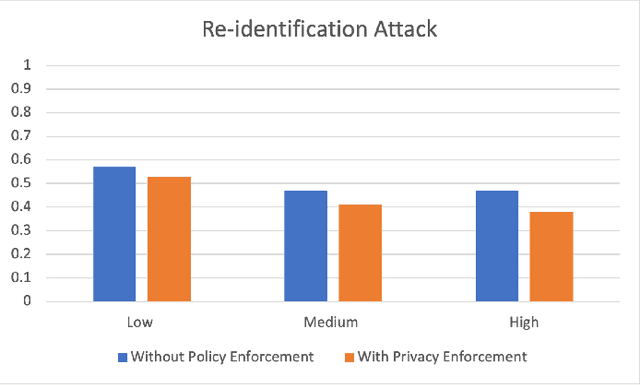
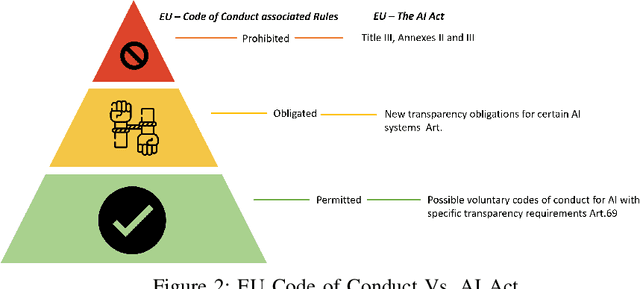
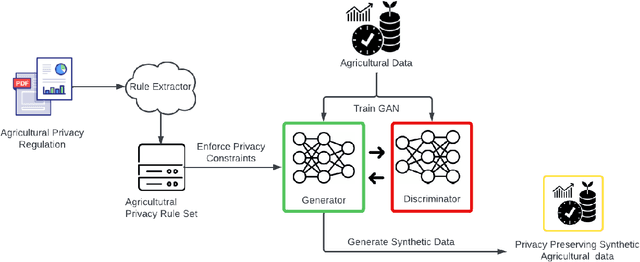
Abstract:Big Data empowers the farming community with the information needed to optimize resource usage, increase productivity, and enhance the sustainability of agricultural practices. The use of Big Data in farming requires the collection and analysis of data from various sources such as sensors, satellites, and farmer surveys. While Big Data can provide the farming community with valuable insights and improve efficiency, there is significant concern regarding the security of this data as well as the privacy of the participants. Privacy regulations, such as the EU GDPR, the EU Code of Conduct on agricultural data sharing by contractual agreement, and the proposed EU AI law, have been created to address the issue of data privacy and provide specific guidelines on when and how data can be shared between organizations. To make confidential agricultural data widely available for Big Data analysis without violating the privacy of the data subjects, we consider privacy-preserving methods of data sharing in agriculture. Deep learning-based synthetic data generation has been proposed for privacy-preserving data sharing. However, there is a lack of compliance with documented data privacy policies in such privacy-preserving efforts. In this study, we propose a novel framework for enforcing privacy policy rules in privacy-preserving data generation algorithms. We explore several available agricultural codes of conduct, extract knowledge related to the privacy constraints in data, and use the extracted knowledge to define privacy bounds in a privacy-preserving generative model. We use our framework to generate synthetic agricultural data and present experimental results that demonstrate the utility of the synthetic dataset in downstream tasks. We also show that our framework can evade potential threats and secure data based on applicable regulatory policy rules.
Advances in Cybercrime Prediction: A Survey of Machine, Deep, Transfer, and Adaptive Learning Techniques
Apr 10, 2023



Abstract:Cybercrime is a growing threat to organizations and individuals worldwide, with criminals using increasingly sophisticated techniques to breach security systems and steal sensitive data. In recent years, machine learning, deep learning, and transfer learning techniques have emerged as promising tools for predicting cybercrime and preventing it before it occurs. This paper aims to provide a comprehensive survey of the latest advancements in cybercrime prediction using above mentioned techniques, highlighting the latest research related to each approach. For this purpose, we reviewed more than 150 research articles and discussed around 50 most recent and relevant research articles. We start the review by discussing some common methods used by cyber criminals and then focus on the latest machine learning techniques and deep learning techniques, such as recurrent and convolutional neural networks, which were effective in detecting anomalous behavior and identifying potential threats. We also discuss transfer learning, which allows models trained on one dataset to be adapted for use on another dataset, and then focus on active and reinforcement Learning as part of early-stage algorithmic research in cybercrime prediction. Finally, we discuss critical innovations, research gaps, and future research opportunities in Cybercrime prediction. Overall, this paper presents a holistic view of cutting-edge developments in cybercrime prediction, shedding light on the strengths and limitations of each method and equipping researchers and practitioners with essential insights, publicly available datasets, and resources necessary to develop efficient cybercrime prediction systems.
Crime Prediction Using Machine Learning and Deep Learning: A Systematic Review and Future Directions
Mar 28, 2023



Abstract:Predicting crime using machine learning and deep learning techniques has gained considerable attention from researchers in recent years, focusing on identifying patterns and trends in crime occurrences. This review paper examines over 150 articles to explore the various machine learning and deep learning algorithms applied to predict crime. The study provides access to the datasets used for crime prediction by researchers and analyzes prominent approaches applied in machine learning and deep learning algorithms to predict crime, offering insights into different trends and factors related to criminal activities. Additionally, the paper highlights potential gaps and future directions that can enhance the accuracy of crime prediction. Finally, the comprehensive overview of research discussed in this paper on crime prediction using machine learning and deep learning approaches serves as a valuable reference for researchers in this field. By gaining a deeper understanding of crime prediction techniques, law enforcement agencies can develop strategies to prevent and respond to criminal activities more effectively.
 Add to Chrome
Add to Chrome Add to Firefox
Add to Firefox Add to Edge
Add to Edge